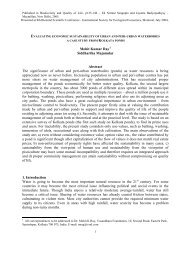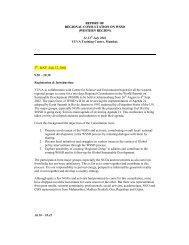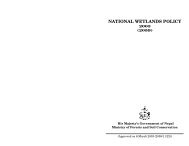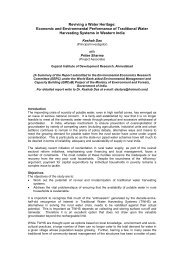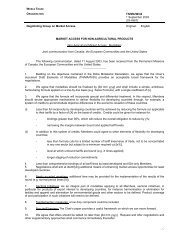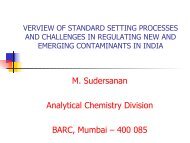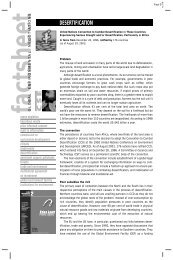Technical details - Rainwater Harvesting
Technical details - Rainwater Harvesting
Technical details - Rainwater Harvesting
Create successful ePaper yourself
Turn your PDF publications into a flip-book with our unique Google optimized e-Paper software.
In alluvial and hard rock areas, there are thousands of wells which have either gone dry or whose water<br />
levels have declined considerably. These can be recharged directly with rooftop run-off. <strong>Rainwater</strong> that is<br />
collected on the rooftop of the building is diverted by drainpipes to a settlement or filtration tank, from which it<br />
flows into the recharge well (borewell or dugwell).<br />
If a tubewell is used for recharging, then the casing (outer pipe) should preferably be a slotted or perforated<br />
pipe so that more surface area is available for the water to percolate. Developing a borewell would increase<br />
its recharging capacity (developing is the process where water or air is forced into the well under pressure to<br />
loosen the soil strata surrounding the bore to make it more permeable).<br />
If a dugwell is used for recharge, the well lining should have openings (weep-holes) at regular intervals to<br />
allow seepage of water through the sides. Dugwells should be covered to prevent mosquito breeding and<br />
entry of leaves and debris. The bottom of recharge wells should be desilted annually to maintain the intake<br />
capacity.<br />
Providing the following elements in the system can ensure the quality of water entering the recharge wells:<br />
1. Filter mesh at entrance point of rooftop drains<br />
2. Settlement chamber<br />
3. Filter bed<br />
2. Settlement tank (chamber)<br />
Settlement tanks are used to remove silt and other floating<br />
impurities from rainwater. A settlement tank is like an ordinary<br />
storage container having provisions for inflow (bringing water from<br />
the catchment), outflow (carrying water to the recharge well) and<br />
overflow. A settlement tank can have an unpaved bottom surface to<br />
allow standing water to percolate into the soil.<br />
In case of excess rainfall, the rate of recharge, especially of<br />
borewells, may not match the rate of rainfall. In such situations, the desilting chamber holds the excess<br />
amount of water till it is soaked up by the recharge structure. Thus, the settlement chamber acts like a buffer<br />
in the system.<br />
Any container, (masonry or concrete underground tanks, old unused tanks, pre-fabricated PVC or<br />
ferrocement tanks) with adequate capacity of storage can be used as a settlement tank.<br />
3. Recharging of service tubewells.<br />
In this case the rooftop runoff is not directly led into the service tubewells, to avoid chances of contamination<br />
of groundwater. Instead rainwater is collected in a recharge well, which is a temporary storage tank (located<br />
near the service tubewell), with a borehole, which is shallower than the water table. This borehole has to be<br />
provided with a casing pipe to prevent the caving in of soil, if the strata is loose. A filter chamber comprising<br />
of sand, gravel and boulders is provided to arrest the impurities.<br />
4. Recharge pits<br />
A recharge pit is 1.5m to 3m wide and 2m to 3m deep. The excavated pit is lined with a brick/stone wall with<br />
openings (weep-holes) at regular intervals. The top area of the pit can be covered with a perforated cover.<br />
Design procedure is the same as that of a settlement tank.<br />
5. Soakaways / Percolation pit<br />
Percolation pits, one of the easiest and most effective means of harvesting rainwater, are generally not more<br />
than 60 x 60 x 60 cm pits, (designed on the basis of expected runoff as described for settlement tanks), filled<br />
with pebbles or brick jelly and river sand, covered with perforated concrete slabs wherever necessary.<br />
6. Recharge trenches<br />
A recharge trench is a continuous trench excavated in the ground and refilled with porous media like<br />
pebbles, boulders or broken bricks. A recharge trench can be 0.5 m to 1 m wide and 1 m to 1.5 m deep. The<br />
length of the recharge trench is decided as per the amount of runoff expected. The recharge trench should<br />
<strong>Technical</strong> Details of <strong>Rainwater</strong> <strong>Harvesting</strong> 13








